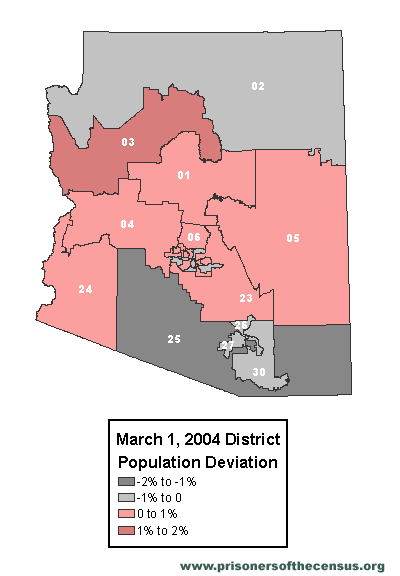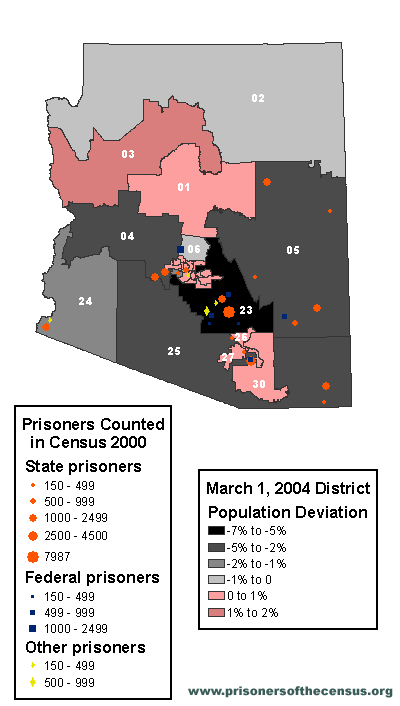Census counts of prisoners stymie Arizona’s efforts to create equally sized districts
by Peter Wagner, March 29, 2004
By official Census numbers, small population deviations between Arizona districts

On March 1, 2004, the Arizona Independent Redistricting Commission released the new maps for the state legislature. The maps are currently open to public comment and will be presented to the Court and the Justice Department for approval in April.
The Commission did a relatively good job of keeping district size deviations to a minimum. (See first map at right.) Ensuring that districts are of equal size is how each resident is guaranteed equal representation under the “one person one vote” principle.
Updating district boundaries after each Census is important so that the districts can reflect the new population. This is doubly important in Arizona, the second fastest growing state in the country. Arizona was 40% larger in 2000 than it was in 1990.
But the Arizona Redistricting Commission failed to account for an even faster growing population: prisoners. The population of state, local, federal and private prisons and jails more than doubled from 1990 to 2000. On Census Day 2000, the U.S. Census counted 45,783 people in correctional facilities in Arizona and assigned each of these individuals to the prison’s address.
This method of counting prisoners may have made sense when the Census began, but it is not helpful for redistricting which requires accurate counts of actual residents. Hidden in the Census data is a measurable shift in the population of the state. In fact, when the Redistricting Commission relies on Census data that counts prisoners as residents of the prison, it violates the Arizona Constitution’s definition of residence: “no person shall be deemed to have gained or lost a residence … while confined in any public jail or prison.”
Without the prisoners as population, districts would be far from equally sized.

The Arizona Redistricting Commission’s carefully drawn districts are markedly less equal when state, federal, and private prison populations are removed. One district, number 23, is under-populated 7%. (See second map at right.)
If the prisoners had been counted at home, the proposed district boundaries would likely create some overpopulated districts. Huge Maricopa County is 59% of the state population but supplies 64% of the state’s prisoners. Unfortunately, more detailed information on where prisoners in Maricopa County originate has not yet been published. But the geographic disparity in incarceration is obvious regardless, because only 19% of the Arizona prisoners in state prisons are incarcerated in Maricopa County. Said another way, at least 71% of Maricopa County’s state prisoners are incarcerated and represented outside the county.
The Arizona Redistricting Commission did a good job getting their districts to match what the Census reported as the population. The next step towards democratically empowered districts would be for the Census to count the population in a way that complies with the Arizona constitution. Prisoners should be counted where they actually reside: at home.
Sources: Rose Heyer analyzed the district populations and made the maps that accompany this article. The article is based on the following: U.S. Census Summary File 1 for 1990 and 2000; Arizona American Friends Service Committee Overview of Prison Privatization in Arizona; Arizona Constitution Article 7, Section 3; Arizona Independent Redistricting Commission district outlines & population tables.



